Sagaing travel - Myanmar, Asia
Sagaing, located about 20 km southwest of Mandalay along the banks of the Irrawaddy River, is renowned for its stunning landscape dotted with over 600 Buddhist pagodas and monasteries. Known historically as Zeyapura, or the "city of victory," Sagaing serves as an important religious center, attracting monks and meditation practitioners from across Myanmar.
The city is a spiritual hub, attracting monks and pilgrims, and is home to notable landmarks such as the iconic Kaunghmudaw Pagoda and U Min Thonze Cave, both of which showcase the area's architectural beauty and religious devotion. Visitors are drawn to Sagaing for its serene atmosphere, cultural experiences, and opportunities to engage with local crafts like silversmithing.
Population: Approximately 300.000 people as of 2024.
Economy: Agriculture is the chief occupation, with rice and wheat being the leading crops; Sagaing is responsible for over 80% of Myanmar's wheat production. The region also produces a variety of other crops, including sesame, peanuts, and pulses, benefiting from irrigation schemes that support farming in the dry zone.
In addition to agriculture, Sagaing has a significant industrial presence, including rice mills, edible oil production, and textile manufacturing. The area is rich in natural resources, with gold, coal, and salt being extracted, and it is known for its traditional crafts such as silverware and lacquerware.
Attractions: Kaunghmudaw Pagoda, Shwe Mohtaw Pagoda, Yadanar Zedi Sinmyar Shin Pagoda, Sagaing Hill, Soon U Ponya Shin Pagoda, U Min Thonze Cave, Sone Oo Pone Nya Shin Pagoda
Myanmar
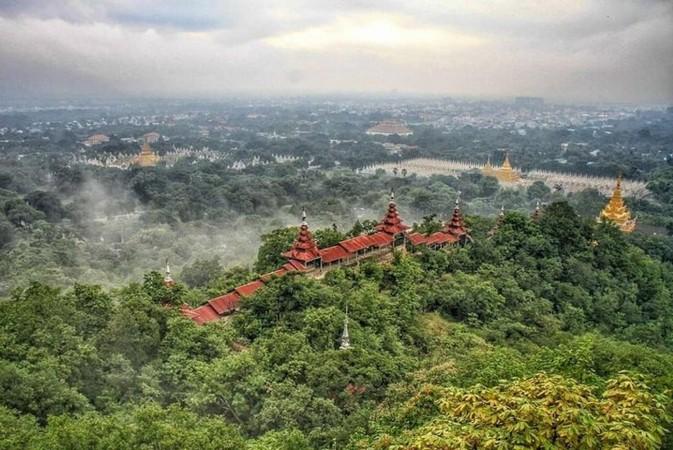
Overview of Sagaing
History & Cultural Influence
Once a royal capital from 1760 to 1764, Sagaing is now renowned as a major religious center, home to over 600 monasteries and pagodas, which reflect its deep-rooted Buddhist heritage. The presence of these religious structures, including the iconic Kaunghmudaw Pagoda, showcases the city's architectural significance and its role as a pilgrimage site for Buddhists.
Historically, Sagaing was part of the Sagaing Kingdom, which existed from 1315 to 1365 and contributed to the region's political and cultural development. The city has been a hub for Theravada Buddhism, with many monks residing in the area, influencing both local governance and agricultural practices.
Interaction with The Locals
When interacting with locals in Sagaing, visitors can expect a warm and welcoming atmosphere characterized by the region's rich cultural and religious heritage. The population is diverse, predominantly consisting of Bamar people, along with significant communities of Shan, Naga, and Chin ethnic groups. This ethnic diversity contributes to a vibrant cultural tapestry and various local customs.
The general attitude towards tourists in Sagaing is friendly and hospitable, as locals often take pride in sharing their traditions and way of life. Visitors may find that many residents are eager to engage in conversation, share stories about their culture, and offer assistance. However, it is important to approach interactions with respect for local customs, especially in religious settings.
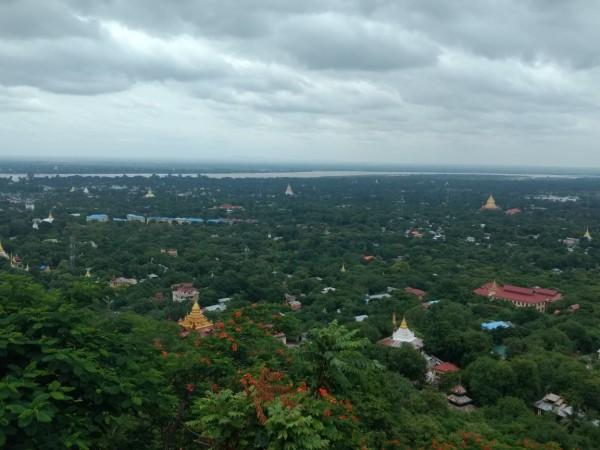
Sagaing Region - © gather
Top attractions in Sagaing
Known for its serene landscapes dotted with pagodas and monasteries, is a spiritual hub in Myanmar. These sites not only provide spiritual nourishment but also offer deep insights into Sagaing's rich Buddhist traditions.
Kaunghmudaw Pagoda
Location: On the northwestern outskirts of Sagaing
The iconic Kaunghmudaw Pagoda, recognized for its unique dome-shaped stupa, stands as a significant religious site in the region. Its structure reflects the traditional Burmese architectural style and serves as a focal point for pilgrimage and cultural heritage.
Sagaing Hill
Location: Southwest of Sagaing city center
Sagaing Hill, adorned with numerous pagodas and monasteries, offers breathtaking views of the Irrawaddy River and the surrounding plains. This area is renowned for its tranquility and is a popular destination for meditation, providing a serene retreat from the bustling city life.
U Min Thonze Cave
Location: atop of Sagaing Hill
U Min Thonze Cave is celebrated for its striking row of Buddha statues set within a picturesque cave. This site attracts pilgrims and tourists alike, offering a peaceful setting for spiritual reflection and insight into local Buddhist practices.
Mingun Pahtodawgyi
Location: In Mingun, about 1 hour across the river from Sagaing
Known for its colossal structure, Mingun Pahtodawgyi is an awe-inspiring sight as an unfinished pagoda initially intended to be the world's largest. The site also features the Mingun Bell, claimed to be the largest ringing bell globally, adding to its historical significance.
Mya Thein Tan Pagoda
Location: in a small town called Mingun, Near Sagaing
The Mya Thein Tan Pagoda, with its distinctive seven-tiered design, is surrounded by lush gardens, making it an idyllic spot for relaxation and spiritual rejuvenation. The pagoda's architecture and tranquil surroundings attract those seeking peace and beauty.
Phoe Win Tuang Cave
Location: on the western bank of the Chindwin River
Phoe Win Tuang Cave is a revered site housing hundreds of Buddha images, representing the devotion and religious heritage of the region. It is a significant meditation and reflection site, reflecting the deep spiritual roots of the local community.
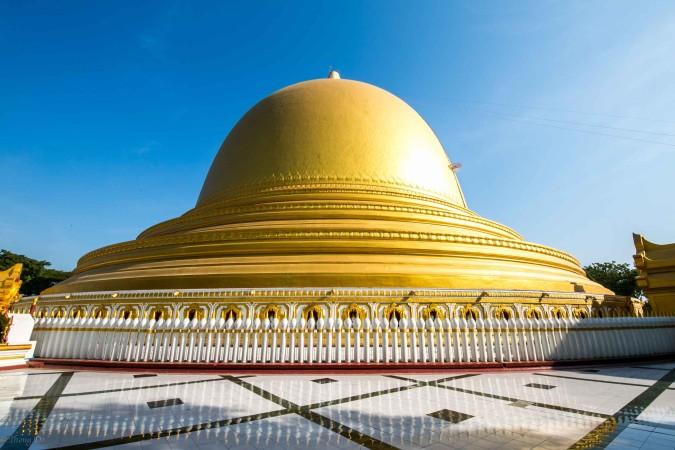
Kaunghmudaw Pagoda - © gather
Must-Try Dishes in Sagaing
Sagaing offers a tantalizing array of traditional Burmese dishes that reflect the region's rich culinary heritage. From a savory fish broth noodle soup to the Tea Leaf Salad, combines fermented tea leaves with a crunchy mix of nuts and seeds, offering a unique blend of textures and flavors that is both refreshing and distinctly Burmese. These dishes not only satisfy the palate but also provide a deep dive into the traditional food culture of Sagaing.
Mohinga
Mohinga is often considered the national dish of Myanmar, featuring a savory fish broth soup served with rice noodles. It is commonly enhanced with boiled eggs, cilantro, and crispy fritters. As a staple breakfast item, Mohinga exemplifies the local preference for flavorful, hearty meals and highlights the region's abundant fish resources.
Ohn No Khao Swe
Ohn No Khao Swe is a rich coconut milk-based noodle soup with chicken, traditionally served with egg noodles and garnished with onions, lime, and sometimes boiled eggs. This dish reflects the influence of Indian cuisine in Myanmar, particularly in Sagaing, where the use of coconut milk is prevalent.
Shan Tofu
Shan Tofu, made from chickpea flour, presents a soft, custard-like texture and is typically served in salads or fried. This dish is unique to the Shan State and popular in Sagaing, showcasing the region’s use of local agricultural products and traditional cooking techniques.
Laphet Thoke (Tea Leaf Salad)
Laphet Thoke is made from fermented tea leaves mixed with nuts, peas, garlic, and sesame oil, and is often served with a variety of toppings. As a cultural delicacy in Myanmar, it symbolizes hospitality and community, commonly enjoyed during social gatherings.
Grilled Fish
Freshwater fish from the Irrawaddy River is grilled and seasoned with local spices and herbs to create this dish. Grilled fish is a popular choice in Sagaing, reflecting the region’s rich aquatic resources and the local preference for fresh, flavorful ingredients.
Htamin Jin (Rice Salad)
Htamin Jin is a resourceful salad made from leftover rice mixed with various vegetables, herbs, and sometimes meat, served cold. This dish exemplifies the practical and delicious ways local cuisine utilizes leftover ingredients, showcasing the resourcefulness of the region’s food practices.
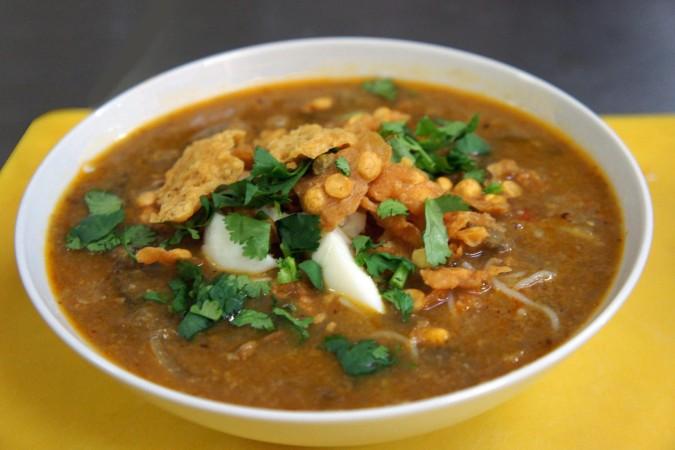
Mohinga - © gather
Festivals & Local Celebrations
Kaunghmudaw Pagoda Festival
When: Early to mid-November
Takes place on the Full Moon day of Tazaungmon and features unique sights like locals arriving in oxcarts and bringing hand-woven cloths and mats. Visitors can watch traditional Myanmar puppet shows and admire the scenic view of Sagaing.
Naga New Year Festival
When: March 20
Also known as the Naga National Day, this festival celebrates the Naga ethnic group and attracts tourists to join in the celebration while enjoying Sagaing's natural beauty.
Shwe Kyin Light Festival
When: October, after the Full Moon Day of Thadingyut
Celebrated in the Bago Region but is worth mentioning for Sagaing visitors. It features boat races, traditional dance and music performances on boats, and the mesmerizing release of lit paper lanterns onto the river, believed to bring good luck
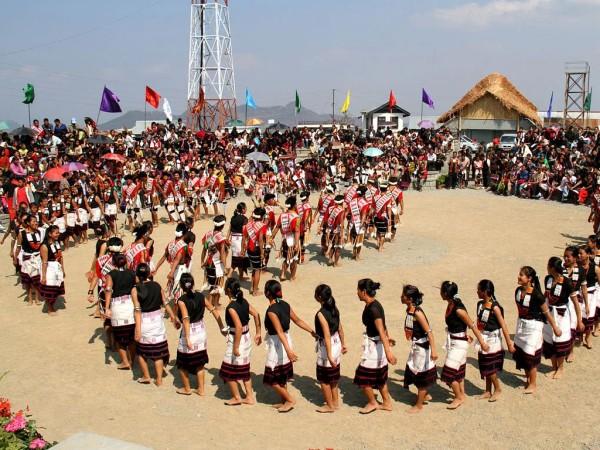
Naga New Year Festival - © gather
Weather in Sagaing: Best Time to Visit
Sagaing experiences a hot semi-arid climate, characterized by distinct wet and dry seasons. Here are the key details about its weather and climate:
Average Temperatures
- Yearly Average: Approximately 27.8°C (82°F).
- Warmest Month: April, with average highs reaching around 38.3°C (100.9°F).
- Coldest Month: January, with average lows around 14.5°C (58.1°F).
Rainfall
- Annual Precipitation: About 804 mm (31.65 inches), with the rainy season typically lasting from May to October.
- Wettest Months: July and August receive the highest rainfall, averaging around 66.2 mm (2.61 inches) and 126.2 mm (4.97 inches), respectively.
Best Time to Travel
- Optimal Travel Period: The best time to visit Sagaing is during the dry season from November to February when temperatures are cooler and rainfall is minimal, making it ideal for outdoor activities and sightseeing.

U Min Thonze Cave - © Roger Price
Culture Etiquette in Sagaing
Respect for Monks and Temples
- Dress modestly, covering shoulders and knees, when visiting temples and monasteries.
- Remove shoes before entering religious buildings.
- Avoid touching monks or passing objects over their heads.
- Do not point your feet towards Buddha images or monks.
Greetings and Interactions
- Greet elders and those in positions of authority with respect, using "U" for older men and "Daw" for older women.
- Avoid touching someone's head, as it is considered the most sacred part of the body.
- Use your right hand when giving or receiving items, as the left hand is traditionally associated with unclean tasks.
- Bow your head slightly when walking in front of someone senior who is seated.
Dress Code
- Wear modest, conservative clothing that covers shoulders and knees, especially when visiting religious sites.
- Remove shoes before entering temples, monasteries, homes, and sometimes even offices.

Mingun Pahtodawgyi pagoda - © Andrey Omelyanchuk
Essential Travel Information
Getting to Sagaing
From Mandalay: Located just 20 km (12 miles) southwest of Mandalay, Sagaing is easily accessible.
- Taxi: Taxis are a convenient option, with fares typically around USD 10 (MMK 15,000) for the trip from Mandalay to Sagaing.
- Bus: Local buses run frequently between the two cities, offering an affordable and budget-friendly way to travel.
Public Transit
- Buses: Sagaing has a network of local buses that connect different parts of the city and nearby attractions. They are a low-cost option, though schedules can vary.
Taxis and Ride-Sharing
- Taxis: Taxis are widely available in Sagaing, and fares should be negotiated before starting your journey. Expect to pay about USD 3-5 for short trips within the city.
- Ride-Sharing: While popular apps like Grab might not be widespread, local taxis can often be hired through phone apps or hailed directly on the street.
River Transportation
- Boat Rides: The Irrawaddy River offers scenic boat trips, giving travelers a unique perspective of the river and surrounding landscapes. These rides often showcase local life, including traditional fishing activities.
Local Transportation
- Bicycles and Motorbikes: Renting a bicycle is a great way to explore Sagaing at your own pace. Motorbike taxis are also available, but it's best to use them with caution for safety reasons.
Accommodation Choices
Sagaing offers a variety of accommodations to suit all budgets:
Budget Hotels:
- Shwe Pyi Thar Hotel
- Sagaing City Hotel
- Sagaing View Hotel
Mid-Range Hotels:
- Yadanarbon Hotel
- Sagaing Hill Resort
- Sagaing Palace Hotel
Luxury Resorts:
- Sagaing Hill Resort
- Sagaing View Resort
- Yadanarbon Resort
Hostels and Guesthouses are available in Sagaing City Center for budget-conscious travelers, while Airbnb offers private apartments and short-term rental options for a more personalized stay.
Articles for you

Explore Yala National Park - Sri Lanka Travel, Asia
Tucked away in Sri Lanka’s southeastern corner, Yala National Park is where wild nature meets deep tradition. Known worldwide for its leopard population, the park is also home to elephants, sloth bears, crocodiles, and hundreds of bird species. Beyond wildlife, Yala opens doors to a cultural landscape dotted with ancient temples, Buddhist ruins, and coastal villages. For travelers seeking more than just a safari, Yala offers a chance to explore eco-tourism, local communities, and sacred heritage sites.
Population: The Yala National Park area doesn’t have a human population.
Economy: The economy around Yala National Park thrives on a blend of eco-tourism, agriculture, and local services. Safari tours, eco-lodges, and cultural experiences drive steady income for nearby towns like Tissamaharama and Kataragama, supporting thousands of families.
Landmarks: Famous for Block I of Yala and wildlife encounters, including elephants, sloth bears, crocodiles, and exotic bird species.

Explore Galle - Sri Lanka Travel, Asia
Nestled on Sri Lanka’s southern coastline, Galle is a vibrant city where history meets the sea. Its cobbled streets, colonial architecture, and serene beaches make it a must-visit destination for travelers seeking a blend of culture, adventure, and relaxation. A UNESCO World Heritage site, Galle captivates visitors with its Dutch Fort, bustling markets, and friendly locals. Whether you’re exploring the ramparts at sunset or savoring fresh seafood by the shore, Galle promises an unforgettable journey into Sri Lanka’s heritage.
Population: Approximately 113,000 in 2023.
Economy: Galle’s economy thrives on tourism, trade, and fisheries. The city’s historic fort, colonial architecture, and coastal charm draw thousands of international visitors each year, making tourism its main economic driver. Fishing remains vital for local livelihoods, supplying fresh seafood across the region.
Landmarks: Famous for the Galle Fort, Dutch Reformed Church & Maritime Museum, and Unawatuna Beach.

Explore Bentota - Sri Lanka Travel, Asia
Nestled along Sri Lanka’s southwestern coast, Bentota is a tropical paradise that blends golden beaches, vibrant culture, and thrilling adventures. Famous for its calm waters, luxury resorts, and scenic river estuary, Bentota has become a top destination for travelers seeking both relaxation and authentic experiences. From serene beach walks at sunrise to adrenaline-pumping water sports, this coastal town offers a perfect balance of leisure and exploration. With its proximity to Colombo and Galle, Bentota is easy to reach, making it an ideal stop for both short escapes and extended holidays.
Population: Approximately 37,000 in 2023.
Economy: Bentota’s economy thrives mainly on tourism, which drives local businesses such as hotels, restaurants, and wellness retreats. The town also benefits from fishing, coconut cultivation, and handicrafts like wood carving and batik textiles. Many residents rely on the growing demand for water sports and Ayurvedic treatments, making tourism the backbone of both income and employment in the area.
Landmarks: Famous for Bentota Beach, Bentota River Safari, and Kande Vihara Temple.

Explore Mirissa - Sri Lanka Travel, Asia
Mirissa is a charming coastal town on Sri Lanka’s southern shoreline. Known for its golden beaches, turquoise waters, and vibrant marine life, it has become a must-visit stop for travelers exploring the island. Many come for whale watching, surfing, and sunset views at Coconut Tree Hill, but Mirissa offers much more than postcard beauty. The fishing boats you see anchored by the bay carry generations of stories. Local traditions, delicious cuisine, and a laid-back rhythm of life shape every visitor’s experience.
Population: Approximately 4,700 in 2023.
Economy: Mirissa’s economy is largely shaped by its coastal location. Fishing has long been the backbone of local livelihoods, with generations relying on the Indian Ocean for income. In recent decades, tourism has become the main driver of growth, thanks to whale watching, surfing, and beachside hospitality.
Landmarks: Famous for Mirissa Beach, Coconut Tree Hill, and Parrot Rock Bridge.

Explore Nuwara Eliya - Sri Lanka Travel, Asia
Tucked away in the Central Highlands of Sri Lanka, Nuwara Eliya is often called “Little England”. With its rolling tea plantations, cool misty mornings, and colonial charm, this mountain town feels like a step into another world. Travelers come here to breathe fresh air, walk through flower gardens, sip the finest Ceylon Tea, and enjoy a pace of life far from the island’s busy cities. Whether you’re drawn by scenic landscapes, heritage architecture, or the warmth of its people, Nuwara Eliya is a destination that blends nature, culture, and history in perfect harmony.
Population: Approximately 781,000 in 2023.
Economy: Nuwara Eliya’s economy thrives mainly on tea production, as it sits in the heart of Sri Lanka’s central highlands, famous worldwide for Ceylon Tea. The city also benefits from a growing tourism industry, attracting visitors with its colonial charm, cool climate, and scenic landscapes.
Landmarks: Famous for Gregory Lake, Hakgala Botanical Garden, and Victoria Park.

Explore Sukau - Malaysia Travel, Asia
Nestled on the banks of the Kinabatangan River in Sabah, Malaysian Borneo, Sukau is a destination where wildlife, culture, and conservation come together. Known as one of Asia’s top spots for river safaris and eco-tourism, this quiet village offers a front-row seat to encounters with Bornean orangutans, pygmy elephants, proboscis monkeys, and exotic birdlife.
Population: Approximately 1,400 in 2019.
Economy: Sukau’s economy is shaped by its riverine location and natural resources. Traditionally, the Orang Sungai community relied on fishing, small-scale farming, and forest gathering for their livelihood. Today, the village has shifted toward eco-tourism, with river cruises, jungle trekking, and homestays providing income.
Landmarks: Famous for the Kinabatangan River cruises, Gomantong Caves, and Ox-bow lakes and wetlands.
